on German cars, hybrids, EVs, and even ICEs
BMW Neue Klasse. . .VW Group turns to design. . .the non-uniformity of taste. . .Toyota’s Crown. . .BYD launches new hybrid. . .Europeans still build plenty of internal combustion engines. . .
#hybrid
The BMW Neue Klasse: Three Areas of Interest
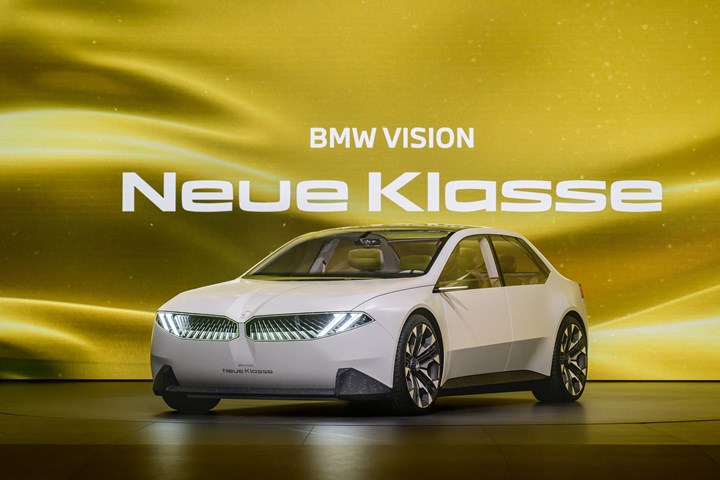
BMW brings design and technology to its forthcoming EV. (Image: BMW)
Writing about the BMW Vision Neue Klasse, which was introduced last week in Munich (even if there wasn’t a show there, where else?), Rain Noe of design site Core77 observed:
“I think it’s just fantastic. In contrast to some of their recent models, which look like they were designed by AI, this looks like a modern German car. It’s got that perfectly reconciled, confident form that doesn’t need slashes, creases and scoops to draw your eye.”
The comment about recent models is one of the more restrained descriptions.
Evidently BMW design is back.
The Neue Klasse is not only creating a new form language for BMWs that has clear resonance, the concept, which is to become an actual production vehicle in 2025, is ushering in some notable changes at the company.
Three Areas
Oliver Zipse, chairman of the Board of Management of BMW AG, said the car “combines our ability to innovation in the core areas of electrification, digitalization and circularity.”
1.
Of the first, yes, this is an electric vehicle. While not providing specifics, Frank Weber, who is on the BMW board responsible for Development, said, “30% more range, 30% faster charging, 25% more efficiency.”
These will be achieved for the sixth gen of BMW eDrive, in part, by new electric motors as well as round battery cells that are said to have 20% more energy density than the prismatic cells they’ll replace.
3.
As for the circularity, not only will the vehicle be manufactured with, for example, “secondary raw materials,” but will be produced in an energy-efficient plant being built in Debrecen, Hungary.
2.
But it is the middle area—digitalization—that may be the most notable aspect of how the Neue Klasse will have consequences beyond a vehicle.
The factory, for example, is being developed with the NVIDIA Omniverse Enterprise. This allows the building and operating a virtual factory—running real time digital twins to determine the parameters for everything from logistics to robotics.
In the vehicle there will be the deployment of the next-gen iDrive, which is based on a new software architecture. BMW has a Cloud Data Hub presently residing on the AWS system. That information and more will be further developed—using AWS compute, generative AI, IoT, machine learning, and storage—for the creation of next-gen ADAS.
Dr. Nicolai Martin, senior vice president of Driving Experience at BMW Group:
“In the next decade, consumer habits and expectations will drive more changes in the automotive industry than we’ve seen over the past 30 years. This is just the beginning of a new era of highly automated driving, fueled by innovations in technology and engineering. By collaborating with AWS, the BMW Group, along with our partner, Qualcomm Technologies, is building our new automated driving platform on AWS’s scalable, secure, and reliable infrastructure. We’re tapping into AWS’s ability to help empower the next generation of BMW’s automated driving and parking functions.”
Observation
When BMW is working with companies like NVIDIA, AWS and Qualcomm to develop process and product, it is clear that the auto industry is no longer where it was even 10 years ago.
And when a BMW senior vp of Driving Experience mentions next-gen parking. . . well, the world is changing.
///
“Design,” He Said: VW Group’s New Approach

Michael Mauer, Head of Group Design and Head of Porsche Design (left), and Oliver Blume, Volkswagen Group CEO (right). “People automatically relate to a brand through design because it communicates with them as an emotional language. In Volkswagen Group’s multi-brand universe, with customers ranging from the Ducati pilot to the Scania trucker, each brand needs its own strong personality, with a unique and distinctive character,” explains Mauer (Image: VW)
Like most auto companies at the 2023 IAA in Munich, Volkswagen Group* rolled out with fresh sheet metal, like the ID.GTI Concept car and the CUPRA DarkRebel show car.
Like German auto companies, when making a media presentation there was a focus on the business strategy in a way that seems, well, foreign to OEMs from other countries (in their presentations, it is the vehicle, not how the vehicle has come to be that is the focus).
So when Volkswagen Group CEO Oliver Blume kicked off the Group’s Munich presentation, he provided focus on what the company is doing now and intends to do.
Blume has been in his current position since September 1, 2022, so he has had a year to sort things out and make determinations on the intensions.
The proverbial headline is the name of VW Group’s strategy going forward:
“Success by Design”
"Good design is an essential factor in delighting our customers,” Blume said.
But what’s more interesting is the background he laid out regarding how they’ve arrived at that.
Blume explained that after taking the helm they did an analysis of the organization.
That led to a 10-point program of the Group’s strategic aims:
- Planning round
- Products
- China
- North America
- CARIAD
- Platforms & Technology
- Battery, Charging & Energy
- Mobility Solutions
- Sustainability
- Capital Markets
Which means things like “In China, for China,” the increased focus on developing vehicular software through its CARIAD operation, and making sure that investors understand what the Group is up to.
One interesting aspect of list—and this is in the order presented—is number seven—in part because it is in that position.
Blume did point out the Group is developing EV platforms—Scalable Systems Platform, Premium Platform Electric, Modular Electric Toolkit Plus—and working on the “Unified Cell”—a prismatic package that allows the use of different cells chemistries that will be produced by PowerCo, a company established last year to consolidate the Group’s battery development and production.
But clearly EVs are only part of a larger list of things that must be taken into account.
Blume rhetorically asked, “Why are we doing this?”
And answered that there is a range of reasons: remaining competitive, being a modern and responsible employer offering job security, adding financial value to investors.
He then gave the big answer, one that he said is “deeper, yet way simpler”:
“We want to excite our customers, over and over again. Our focus is on them.”
Blume said that looking ahead, given new parameters, possibilities, challenges, and opportunities; given that traditional values including competitive pricing, quality, production, and innovation excellence are table stakes; given that “products are more comparable,”** something must be done to stand out.
Harkening back to the “legends” of the Group—the VW Beetle and Golf, the Audi Quattro, the Porsche 911, the Lamborghini Countach—Blume said they are counting on designers, who will work more closely with the brands’ CEOs, to make the brands’ products something that will truly excite customers.
That, Blume said, “is the only way to create sustainable value.”
==
*The Group includes Volkswagen, Volkswagen Commercial Vehicles, ŠKODA, SEAT, CUPRA, Audi, Lamborghini, Bentley, Ducati, and Porsche. It has some 676,000 employees and operates 119 production facilities in Europe, the Americas, Asia, and Africa. Group vehicles are available in over 150 countries.
**One of the challenges of electric vehicles is that with few exceptions (e.g., Porsche Taycan Turbo S with a 0 to 60 mph time of 2.6 seconds) their propulsion systems seem rather uniform. So spec-to-spec there are high levels of comparability. Which is why companies need to develop distinctive differences, not just in the Porsche space (Volkswagen Group categorizes Porsche in its Sport Luxury Brand Group), but in the VW and SEAT vehicles, as well.
///
Over There
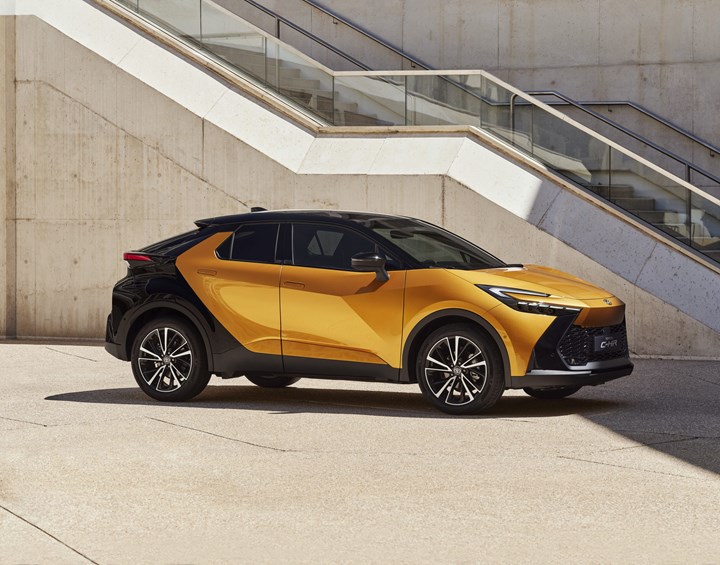
The new Toyota C-HR—which won’t be offered in the U.S. market. (Image: Toyota)
In the U.S. market, the Toyota Corolla Cross, the CUV variant of the Corolla, is doing exceedingly well, especially compared with the other offering Toyota has in the C-segment, the C-HR.
In 2022 Toyota sold 56,666 Corolla Crosses in the U.S. and 12,141 C-HRs.
The C-HR’s best year was calendar year 2018 (it was introduced in 2017 as a model year 2018 vehicle), when 49,642 were delivered.
Clearly the Corolla Cross is what Toyota needs in that segment.
But while the C-HR is being discontinued in the U.S. market, it will continue in Europe, where a new version was recently unveiled.
Global?
While there is a tendency to think that the industry is “global” in the context of being fairly homogenous in terms of what customers want, according to French data analysis firm Inovev, during the first six months of 2023 there were some 9,000 Corolla Crosses sold in Europe—and ~43,000 C-HRs.
Inovev notes the C-HR has “an avant-garde style, while the Corolla Cross has a much more classic appearance.”
And the second generation is at least as avant-garde as its predecessor, so while it won’t play in Peoria, it certainly will in Paris.
///
2023 Toyota Crown Limited

The Toyota Crown: the brand’s top-of-the-line model is a hybrid (one could argue that the Mirai is the peak, but it is available in limited markets in the U.S., unlike the Crown, which is potentially everywhere). (Image: Toyota)
Speaking of Toyota. . . .
Although categorized as a “car” and not a “crossover,” Toyota makes much of the “elevated stance” of the Crown. Part of this is predicated “from standard 19-inch or available 21-inch wheels—the largest ever on a Toyota sedan.”
Like a crossover, there are both black plastic arcs around the wheel arches and a black insert along the rocker.
There is also a black inset in the lower portions of the doors.
All of this is meant to provide a look that makes one imagine the Crown is not so much regal as brawny.
But here’s the thing about that “elevated stance.”
The actual ground clearance of the Crown is 5.8 inches.
The ground clearance of another sedan in the Toyota lineup—the number-one passenger car in the U.S. 21 years running—the Camry, is 5.7 inches.
0.1-inch separates the two.
What is that in real life?
Stack two dimes.
And the Camry comes with 17-, 18- or 19-inch tires.
Seated
Still, if you sit in a Crown then compare that with sitting in a Camry, there is no question that there is a more commanding seating position. The road visibility is probably the same between the two, but you get a sense of seeing more because of the H-point provided by the Crown. (The Camry’s seats put you in a sportier posture.)
However, the Crown is significantly higher than the tallest Camry: 60.6 inches vs. 57.1 inches.
That said, the headroom in both cars, front and rear, varies by no more than a few stacked dimes.
But you get at the very least a better view of the hood of the Crown than of the Camry.
(Full disclosure: While this might seem as though I am damning the Crown with faint disapproval, I will confess that I really like the Toyota Avalon, which was taken out of the lineup and replaced by the Crown. The beneficial characteristics of the Avalon are in inverse relation to the amount of promotion it received.)
Under the Hood
What is under the aforementioned hood is of key interest: a hybrid powertrain.
Only a hybrid powertrain.
In the Limited model driven here (as well as for the XLE trim) there is a system horsepower of 236. This is 184 hp from the 2.5-liter engine, 88 kW from the engine for the front wheels and 40 kW for the rear wheels. (Yes, all Crowns are AWD.)
For the Platinum trim there is the Hybrid MAX system, which produces a stout 340 hp.
But whereas the standard system provides fuel economy of 42 mpg city, 41 highway and 41 combined, the MAX is 29/32/30 mpg. So if fuel efficiency matters, then the 184 hp does the job.
Inside
And while on the subject of numbers, know that the driver and front passenger seats are 8-way powered and in the center of the IP there is a horizontally oriented 12.3-inch touch screen for infotainment purposes.
Below the screen is a small knob (sticking with the metaphor, think about the diameter of a nickel) and below that are switches for the HVAC control.
Just as Toyota seems to be being proven right about people being interested in things like hybrids rather than EVs in big numbers (i.e., note how Ford has announced it is going to be increasing the number of hybrids and dialing back a bit on EVs), dials, knobs and buttons are still highly viable for automotive applications.
(Yes, yes, there are no dials, knobs or buttons on the face of your phone, but your phone is at 0 mph and doesn’t weigh two tons, so interacting with it is completely different than a motor vehicle.)
The Limited interior is well-appointed, as is fitting the top vehicle in the Toyota lineup that isn’t a crossover or SUV.
Pricing?
The MSRP for the Crown Limited is $45,550. It is flanked by the XLE at $39,950 and the Platinum at $52,350.
///
BYD Brings Out a New Hybrid
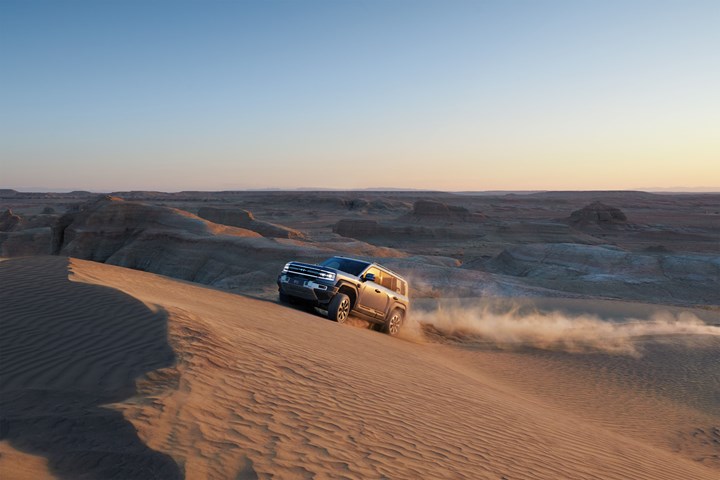
The BYD BAO 5 is a “new energy vehicle” in the Chinese categorization—but a hybrid, not an EV. (Image: BYD)
Speaking of hybrids. . .
Chinese OEM BYD is rapidly gaining market in the “new energy vehicle” (NEV) category, which includes, of course, full electric vehicles as well as hybrids.
To get a sense of the company’s momentum, consider this:
- It took 13 years for the company to produce one million NEVs
- It took 18 months to reach the three-million mark
- It took nine months beyond that to hit five million (which occurred in early August)
Not only does it sell vehicles in China, but is spreading across the world, including Europe—where it is selling sedans, hatches and SUVs—and South America—offering vehicles ranging from crossovers to double-deck buses.
The U.S. market? Given that the U.S. government imposes a 27.5% tariff on Chinese-made cars, odds are the folks at BYD figure there are plenty of other vehicles that can be sold elsewhere before they have to give serious consideration to the U.S. market.
Not an EV
While there is a considerable concentration on full EVs in the U.S.—when you hear about investments in new tech developments, don’t they all seem to be related to them?—BYD has launched a new vehicle, the BAO 5, an SUV based on its new “DMO Super Hybrid Off-Road Platform.”
Yes, a hybrid. A plug-in. But a hybrid, not full EV.
It features what the company describes as its “Revolutionary Non-Load-Bearing Frame Designed for Hybrids.”
Because BYD is working hard on full EVs, too, it has developed what it calls the “Blade Battery.” The lithium iron phosphate battery is configured so that it is long and thin. The battery is integrated into the high-strength steel frame.
The point is not the intro of the BAO 5. Nor that BYD has developed a new sub-brand that will offer vehicles including it, FANGCHENGBAO.
The point is that here’s a company that is not focusing on EVs exclusively.
Certainly there are regulations in places like China and Europe that are making EVs more required, there is still time—measured in years—for alternatives.
///
The Thermal Outlook Remains Reasonably Hot
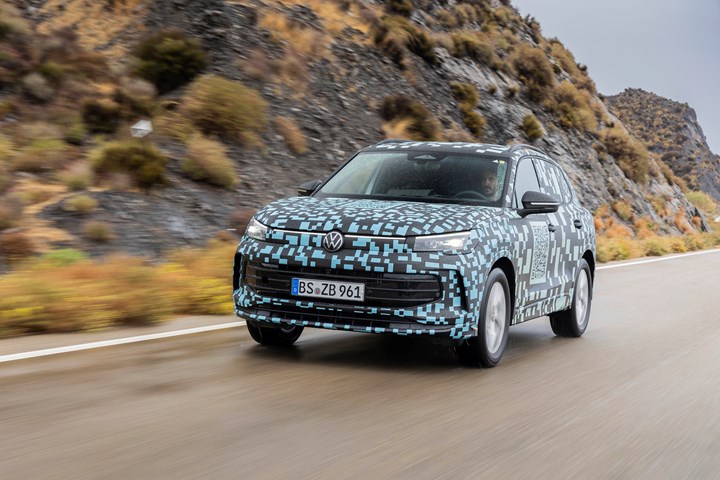
The forthcoming new VW Tiguan. No, it won’t offer than exterior finish. (Image: VW)
And speaking of powertrains. . .
French automotive analysis and forecasting firm Inovev uses a wonderful term for vehicles with internal combustion engines: Thermal.
And that word is used a surprising number of times in a list it put together of the new Euro models making their public debut at the 2023 IAA in Munich.
Looked at from the perspective of projected volumes, it is clear that even in Europe, where the electric vehicle uptake far exceeds that of the U.S., thermal engines aren’t dead.
There are 22 vehicles on the list, new models as well as face lifts.
Ten of the 22 are electric vehicles.
Which means 12 thermal.
The top five vehicles by volume on the list are all thermal:
- VW Tiguan 500,000 annual volume
- BMW 5 Series 250,000
- Mercedes E Class 250,000
- Mini Cooper 200,000
- Renault Clio (facelift) 200,000
Those represent 1,400,000 units.
Summing all of the projected annual volumes for all of the battery electric vehicles on the Inovev list—VW ID.7, Smart #3, Audi Q6 e-tron, Ford Explorer, Mini Cooper, Renault Scenic E-Tech, BMW i5, Opel Corsa, Mini Countryman, Opel Astra—the number is 520,000.
In other words, production of just the top five vehicles, all of which happen to be thermal, is more than twice that of all the EVs.
No, the internal combustion engine isn’t dead. (Even if one puts “yet” at the end of that sentence.)
///
’25 Cadillac CT5: Sure, the LYRIQ & Escalade IQ Get Attention, But. . .
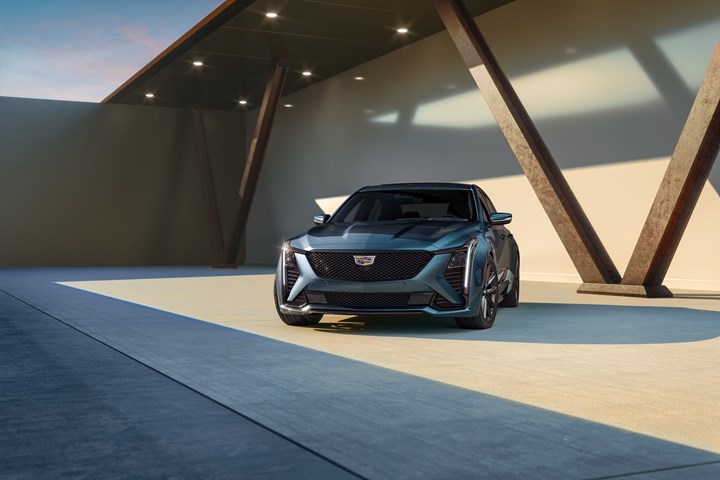
The 2025 Cadillac CT5: a handsome sports sedan that is racking up some serious sales for Cadillac. Yes, a car offered with gasoline engines. (Image: Cadillac)
You’d think that a vehicle that (1) isn’t electric or (2) isn’t an SUV would be something not worthy of a whole lot of attention, but that absolutely is not the case at Cadillac.
Another data point in the “sedans-aren’t-dead, even those not powered by electricity” category comes from John Roth, global vice president of Cadillac.
Roth, in the context of discussing the midcycle refresh of the CT5 sport sedan introduced yesterday, pointed out:
- CT5 had its best August U.S. sales, up 70.6%
- The sedan is up 35.6% so far for the year
- The global CT5 sales are up 27.7% year-over-year
Or as he put it:
“CT5’s importance in Cadillac’s portfolio cannot be overstated.”
The MY 2025 sport sedan features a new front fascia, new lighting back and front, a standard 33-inch-diagonal LED color touchscreen, and other improvements.
It comes standard with a 237-hp 2.0-liter turbo. There’s an optional 335-hp 3.0-liter twin turbo.
Gasoline, not electricity.
The sport sedan will go into production next spring at the GM Lansing Grand River Assembly Plant in Michigan.
Yes, cars still matter.
====
RELATED CONTENT
-
GM Develops a New Electrical Platform
GM engineers create a better electrical architecture that can handle the ever-increasing needs of vehicle systems
-
Startup Readies Solar-Powered EV
Germany’s Sono Motors GmbH says it has received 5,000 orders for its upcoming Sion electric car, which can be partially recharged by it attached solar panels.
-
Honda Pilots “SmartCharge” Program for EV Owners
Honda Motor Co. is launching a “SmartCharge” pilot program that allows customers to coordinate charging times for electric vehicles and plug-in hybrid for non-peak grid times.


.jpg;width=70;height=70;mode=crop)






